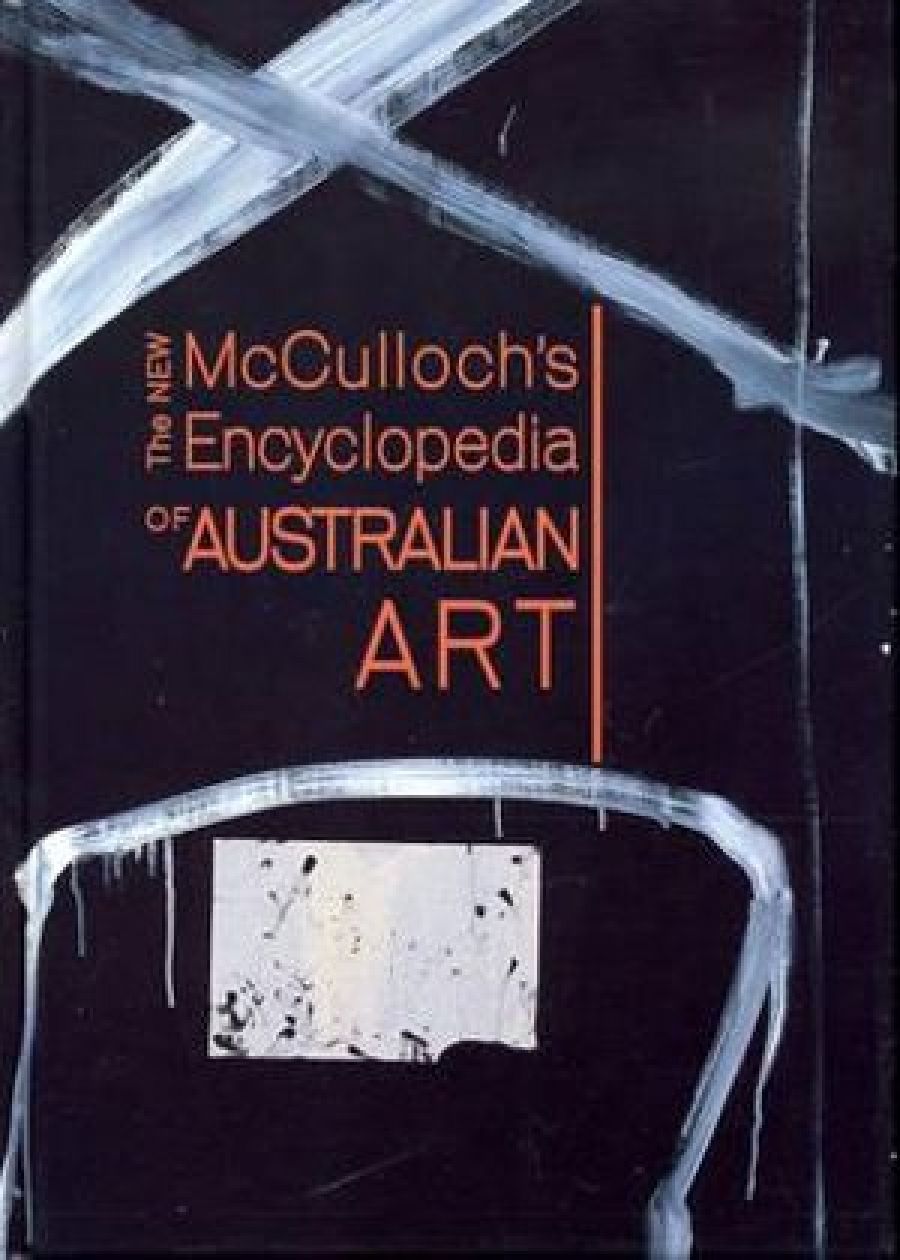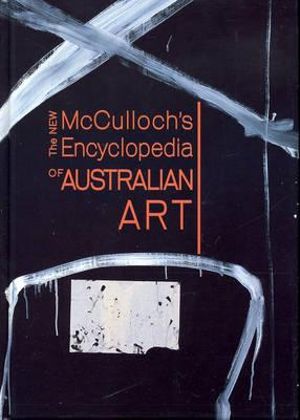
- Free Article: No
- Contents Category: Art
- Review Article: Yes
- Article Title: Too many Tjakamarras?
- Online Only: No
- Custom Highlight Text:
There is no denying the ‘dynastic monument’ that is the fourth edition of the The New McCulloch’s Encyclopedia of Australian Art. Three generations of McCullochs have contributed to this volume, which covers everything from Anita Aarons to Reinis Zusters. With the added title ‘New McCulloch’s’ giving it a personal touch, this edition has more than 8000 listings and includes an extra 1500 entries on artists, awards, directors, critics, exhibitions and galleries; and essays on topics such as abstraction, new media, surrealism and women artists. It is well promoted and marketed, with special editions for the AGNSW and the NGV. It is beautifully produced and an impressive achievement. But is it really Australia’s art ‘bible’?
- Book 1 Title: The New McCulloch's Encyclopedia of Australian Art
- Book 1 Biblio: Miegunyah Press (with Aus Art Editions), $295 hb, 1216 pp
- Book 1 Cover Small (400 x 600):

- Book 1 Cover (800 x 1200):

For anyone teaching Australian art history, an encylopedic reference work is a highly useful tool: a means of quickly checking an artist’s dates, personal details and key works. It can also offer useful descriptions of important styles and movements. However, it is clear that the purpose of the Encyclopedia is not to aid academic scholarship or lecture writing (though the sections on the history of exhibitions will assist researchers). The essays are introductory, general and at times frustratingly oversimplified. There are no entries for decorative arts, symbolism or the Art Movement in Australia; an amalgamated ‘Craft in Australia’ covers it all.
In some respects, it might be called the Australian art equivalent of Who’s Who except for the fact that some important contributors to Australian art history are notably absent. There is no entry for Christopher Allen, Leigh Astbury, Tim Bonyhady, Rex Butler, Ann Galbally, Richard Haese, Ian McLean, or Ann Stephen, while Janine Burke, Robert Nelson, Sebastian Smee, and Ashley Crawford are all mentioned.
Pointing out the Encyclopedia’s market focus is hardly a form of criticism these days. Any realist knows that success in the art world equals big numbers, big money and big pictures. With more than 700 colour illustrations, drawn mostly from private collections and with permissions provided by commercial galleries or auction houses, this single volume tome stands as a testament to what’s hot. As Daniel Thomas pointed out in World of Antiques & Art: ‘the original impulse came largely from the 1960s art market … that is why there has been rather more validation material than we really need.’ For artist entries, the emphasis has most often been put on career highlights rather than detailed analysis of works, but as Bernard Smith has noted, ‘we needed something more comprehensive, more academic, more precise. Other countries have this – it’s an obvious thing to do.’
The task of producing a truly scholarly text thus falls to the soon-to-be-launched Dictionary of Australian Artists Online (DAAO), which has evolved from a project which Smith began in the 1970s, researching Australian content for a new edition of Allgemeines Lexikon der bildenden Kunstler von der Antike bis zur Gegenwart – a widely recognised biographical source on artists comprising thirty-seven volumes. Readers should note that a 100-volume work, Allgemeines Kunstlerlexikon: die bildenden Kunstler aller Zeiten und Volker, is currently in production with forty-five volumes complete.
Our own DAAO is busily converting biographies originally published in reference books, including Joan Kerr’s The Dictionary of Australian Artists: Painters, Sketchers, Photographers and Engravers to 1870 (1992) and Vivien Johnson’s Aboriginal Artists of the Western Desert: A Biographical Dictionary (1994). Kerr’s work is especially important because of her inclusion of indigenous art in the canon of Australian art. According to the website, 437 individual contributors have already contributed biographies. The DAAO, which will be available gratis online, aims to make some of most authoritative work on Australian artists available to a broad audience.
The most disturbing aspect of the Encyclopedia is its 186-page section on Aboriginal art. Why indigenous artists are separated out like this is not made clear. When Susan McCulloch was asked, she replied:
It’s really for the convenience of the reader. It’s not intended to be a separationist thing. It’s just that, when you’re reading – we have several sections that are divided into their own areas, such as exhibitions, galleries and prizes, and we felt that Aboriginal art was so much a contained flow of its own dynamic, interwoven with the rest of Australian art – there are crosses over in the rest of the text as well, but, from a purely practical point of view, we felt that it was much easier for people to look up a Tjupurrula or a Japanangka or a Napanangka in their own section, because you almost need to know what you’re looking for before you can find it, if it’s not in its own section.
Of course, it is easier to keep treating indigenous artists as ‘special cases’ by placing the issues raised by their equality in the too-hard basket. But isn’t it about time we all learned these names and got used to saying them? If it’s a case of too many Tjakamarras, then what about all those Boyds and Lindsays?
Apparently, there were months of discussion over the decision to separate indigenous artists (and most of their supporters) from ‘Australian Art and Artists’. Albert Namatjira and Yirawala, Leonhard Adam and Baldwin Spencer were included in Alan McCulloch’s 1984 edition, but are consigned only to ‘Aboriginal Art’ in this one. Curiously, Rex Battarbee remains in ‘Aboriginal Art’, although his main claim to fame was that he briefly taught but mostly promoted Namatjira. Many other artists have a greater claim for inclusion with the rest of ‘Australian Art’, not because they are well known, like Rover Thomas, Emily Kngwarreye or Clifford Possum, but because they actively oppose being labelled as ‘Aboriginal artists’. Tracey Moffatt, Gordon Bennett and Brook Andrew are just some of the most prominent proponents of this point of view.
Susan McCulloch admits that ‘we really could have written a whole entire other encyclopedia about Aboriginal art’, but the task of bettering The Oxford Companion to Aboriginal Art and Culture (2000) would have proved difficult. Alan McCulloch’s 1984 essay, ‘Aboriginal Art’, with its references to contamination, doom and decline is easily improved upon, but the current effort is hardly the ‘extensive section on Australia’s Aboriginal art with detailed information on artists, community arts centres and regions’ that the marketing arm suggests.
Art these days is a big business, often viewed primarily as a commodity. There are many more new galleries and art magazines, and competition is doubtless tough. But as arts commentator Virginia Trioli has observed, ‘if we go back ten years the magazines that were in existence were discussing art in great detail, they were really devoting themselves to that art practice. Now, the big art magazines are about how to buy art that’s going to increase in value.’
Susan and Emily McCullochs’ effort should be applauded, but this single-volume reference work tries to do too many things. Browsing through the Encyclopedia is pleasurable, and it is refreshing to see illustrations of work that has disappeared into private collections, but, as the Encyclopedia states, ‘there is much that is … overpromoted [in] contemporary Australian art’. I tend to agree.


Comments powered by CComment